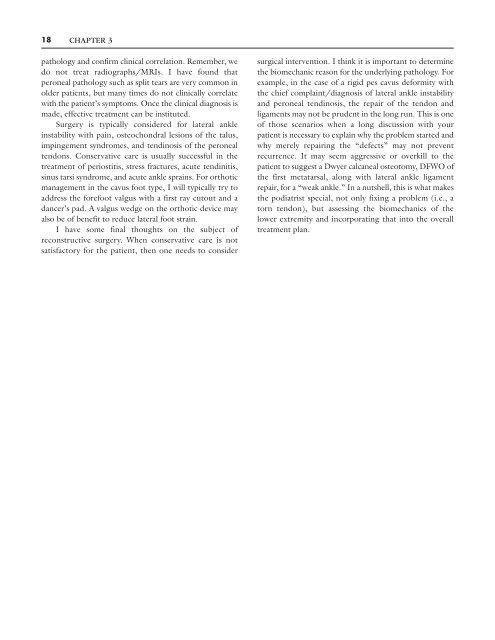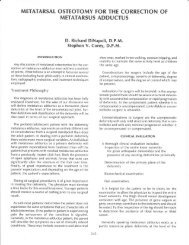lateral pain syndromes of the foot and ankle - The Podiatry Institute
lateral pain syndromes of the foot and ankle - The Podiatry Institute
lateral pain syndromes of the foot and ankle - The Podiatry Institute
Create successful ePaper yourself
Turn your PDF publications into a flip-book with our unique Google optimized e-Paper software.
18<br />
CHAPTER 3<br />
pathology <strong>and</strong> confirm clinical correlation. Remember, we<br />
do not treat radiographs/MRIs. I have found that<br />
peroneal pathology such as split tears are very common in<br />
older patients, but many times do not clinically correlate<br />
with <strong>the</strong> patient’s symptoms. Once <strong>the</strong> clinical diagnosis is<br />
made, effective treatment can be instituted.<br />
Surgery is typically considered for <strong>lateral</strong> <strong>ankle</strong><br />
instability with <strong>pain</strong>, osteochondral lesions <strong>of</strong> <strong>the</strong> talus,<br />
impingement <strong>syndromes</strong>, <strong>and</strong> tendinosis <strong>of</strong> <strong>the</strong> peroneal<br />
tendons. Conservative care is usually successful in <strong>the</strong><br />
treatment <strong>of</strong> periostitis, stress fractures, acute tendinitis,<br />
sinus tarsi syndrome, <strong>and</strong> acute <strong>ankle</strong> sprains. For orthotic<br />
management in <strong>the</strong> cavus <strong>foot</strong> type, I will typically try to<br />
address <strong>the</strong> fore<strong>foot</strong> valgus with a first ray cutout <strong>and</strong> a<br />
dancer’s pad. A valgus wedge on <strong>the</strong> orthotic device may<br />
also be <strong>of</strong> benefit to reduce <strong>lateral</strong> <strong>foot</strong> strain.<br />
I have some final thoughts on <strong>the</strong> subject <strong>of</strong><br />
reconstructive surgery. When conservative care is not<br />
satisfactory for <strong>the</strong> patient, <strong>the</strong>n one needs to consider<br />
surgical intervention. I think it is important to determine<br />
<strong>the</strong> biomechanic reason for <strong>the</strong> underlying pathology. For<br />
example, in <strong>the</strong> case <strong>of</strong> a rigid pes cavus deformity with<br />
<strong>the</strong> chief complaint/diagnosis <strong>of</strong> <strong>lateral</strong> <strong>ankle</strong> instability<br />
<strong>and</strong> peroneal tendinosis, <strong>the</strong> repair <strong>of</strong> <strong>the</strong> tendon <strong>and</strong><br />
ligaments may not be prudent in <strong>the</strong> long run. This is one<br />
<strong>of</strong> those scenarios when a long discussion with your<br />
patient is necessary to explain why <strong>the</strong> problem started <strong>and</strong><br />
why merely repairing <strong>the</strong> “defects” may not prevent<br />
recurrence. It may seem aggressive or overkill to <strong>the</strong><br />
patient to suggest a Dwyer calcaneal osteotomy, DFWO <strong>of</strong><br />
<strong>the</strong> first metatarsal, along with <strong>lateral</strong> <strong>ankle</strong> ligament<br />
repair, for a “weak <strong>ankle</strong>.” In a nutshell, this is what makes<br />
<strong>the</strong> podiatrist special, not only fixing a problem (i.e., a<br />
torn tendon), but assessing <strong>the</strong> biomechanics <strong>of</strong> <strong>the</strong><br />
lower extremity <strong>and</strong> incorporating that into <strong>the</strong> overall<br />
treatment plan.

















